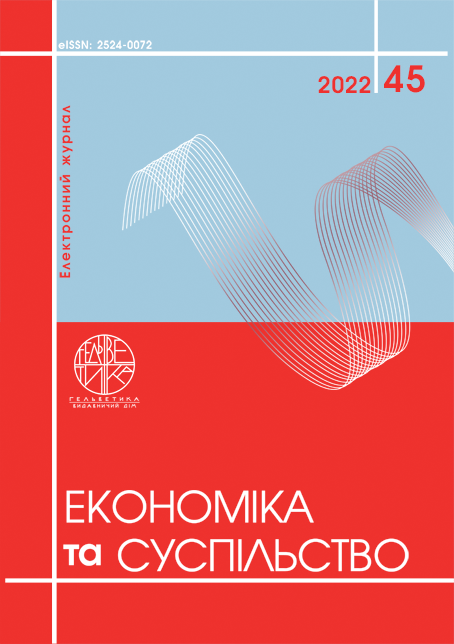PRELIMINARY ANALYSIS AND PREPARATION OF DATA FOR CYBERATTACK TRENDS PREDICTION
Abstract
The article is devoted to the topical issue of combating cyberattacks through the use of forecasting methods. This issue is a consequence of the development of automation in various spheres of society and essential commercial and state companies. Cyber attacks can target multiple infrastructure facilities, which can cause power outages, disable equipment, and steal sensitive data that compromise a country's national security. The current situation related to cyber-attacks was analyzed, and the trends in studying this problem by scientists from various scientific schools and countries were investigated. The research proposed a conceptual model for predicting trends in cyberattacks, which involves the implementation of the preliminary analysis and data preparation stage and the stage of developing a predictive model. Calculations were made based on panel data generated for 40 countries and 30 days. Three types of time trends of cyber-attacks were used as a database of empirical data: the flow of data from malicious programs, suspicious and unwanted mail traffic, and data from detected network attacks. The analysis of the basic statistics revealed the heterogeneity of the data due to the different levels of the countries' development taken for the calculations. The implemented decomposition of trends established the absence of a trend component in the series, the presence of a seasonal element and an additive relationship between the model's parts. An extended Dickey-Fuller test was performed, which confirmed the stationarity of the studied series. The Jarque-Bera test made it possible to reveal the inconsistency of the data with a normal distribution, resulting in the transformation of the variables "x" by logarithmization. The conducted data preparation made it possible to prepare the data for building predictive models of cyberattack trends. Combined regression and regressions with random and fixed effects were chosen as such models. In the future, it is planned to carry out appropriate calculations, build predictive models, assess their accuracy and adequacy, and make forecasts for short-term periods for various countries.
References
World Economic Forum. (2020). The Global Risk Report. Retrieved from: https://www3.weforum.org/docs/WEF_Global_Risk_Report_2020.pdf (December 10, 2022).
IBM Security. (2022). Cost of a Data Breach Report 2022. Retrieved from: https://www.ibm.com/downloads/cas/3R8N1DZJ (December 10, 2022).
Mclean, M. (2022). Must-Know Cyber Attack Statistics and Trendshttps. Retrieved from: www.embroker.com/blog/cyber-attack-statistics/ (December 10, 2022).
Reports largest single day virus spike. Retrieved from: https://abcnews.go.com/Health/wireStory/latest-india-reports-largest-single-day-virus-spike-70826542 (December 10, 2022).
Stacey, P., Taylor, R., & Spanaki, K. (2021). Emotional reactions and coping responses of employees to a cyber-attack: A case study. International Journal of Information Management, 58, 102298. DOI: https://doi.org/10.1016/j.ijinfomgt.2020.102298
Shandler, R. & Gomez, M. A. (2022). The hidden threat of cyber-attacks–undermining public confidence in government. Journal of Information Technology and Politics. DOI: https://doi.org/10.1080/19331681.2022.2112796
Lonsdale, D. J. (2020). The Ethics of Cyber Attack: Pursuing Legitimate Security and the Common Good in Contemporary Conflict Scenarios. Journal of Military Ethics, 19(1), 20–39. DOI: https://doi.org/10.1080/15027570.2020.1764694
Bolpagni, M. (2022). Cyber risk index: a socio-technical composite index for assessing risk of cyber attacks with negative outcome. Quality and Quantity, 56(3), 1643–1659. DOI: https://doi.org/10.1007/s11135-021-01199-3
Simons, G., Danyk, Y., & Maliarchuk, T. (2020). Hybrid war and cyber-attacks: creating legal and operational dilemmas. Global Change, Peace and Security, 32(3), 337–342. DOI: https://doi.org/10.1080/14781158.2020.1732899
Weaver, G. A., Feddersen, B., Marla, L., Wei, D., Rose, A. & Van Moer, M. (2022). Estimating economic losses from cyber-attacks on shipping ports: An optimization-based approach. Transportation Research Part C: Emerging Technologies, 137, 103423. DOI: https://doi.org/10.1016/j.trc.2021.10342
Leroy, I. (2022). The relationship between cyber-attacks and dynamics of company stock: the role of reputation management. International Journal of Electronic Security and Digital Forensics, 14(4), 309–317. DOI: https://doi.org/10.1504/IJESDF.2022.123891
Akoto, W. (2021). International trade and cyber conflict: Decomposing the effect of trade on state-sponsored cyber attacks. Journal of Peace Research, 58(5), 1083–1097. DOI: https://doi.org/10.1177/0022343320964549
Lallie, H. S., Shepherd, L. A., Nurse, J. R.C., Erola, A., Epiphaniou, G., Maple, C., et al. (2021). Cyber security in the age of COVID-19: A timeline and analysis of cyber-crime and cyber-attacks during the pandemic. Computers and Security, 105, 102248. DOI: https://doi.org/10.1016/j.cose.2021.102248


